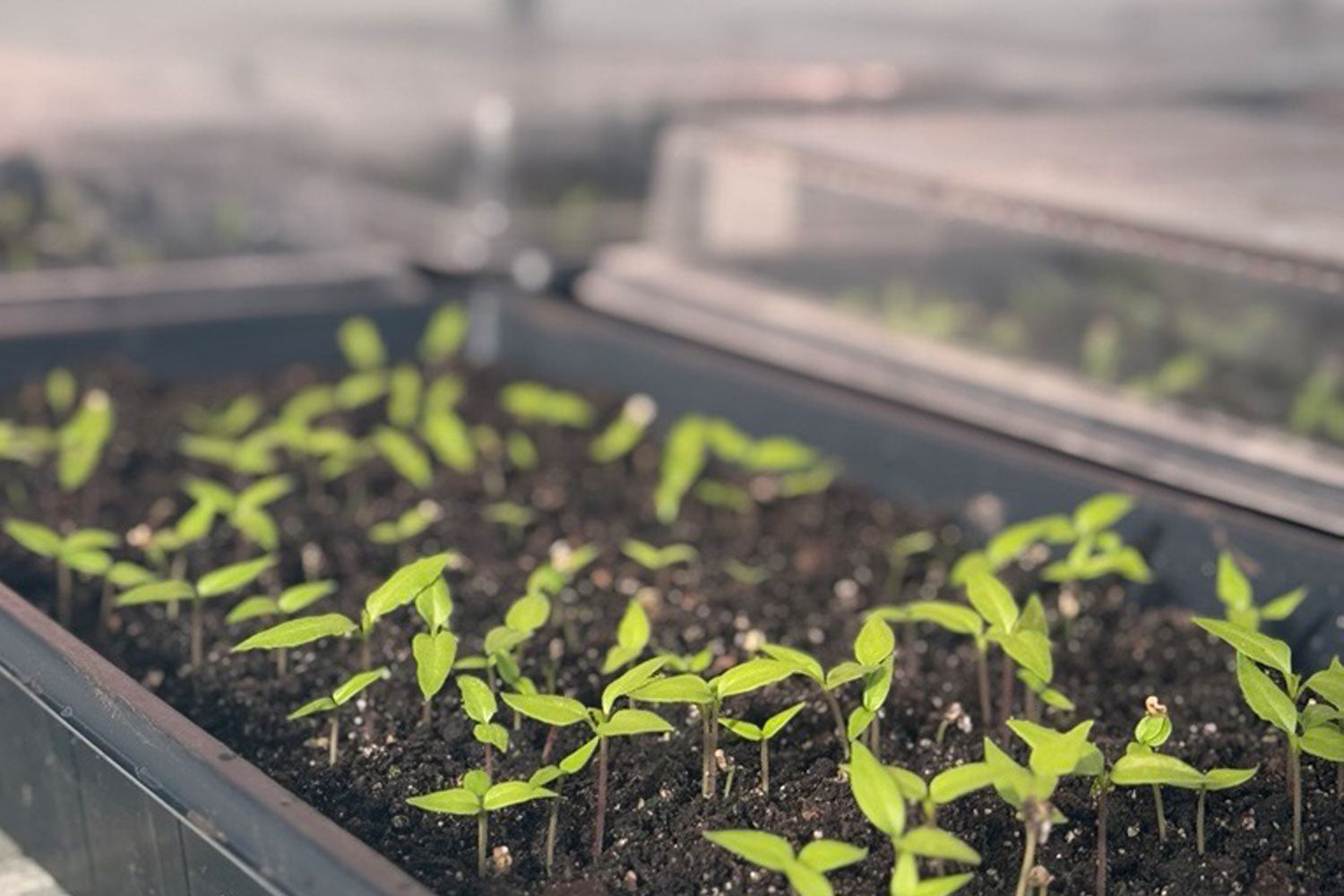Seed Germination FAQ
-
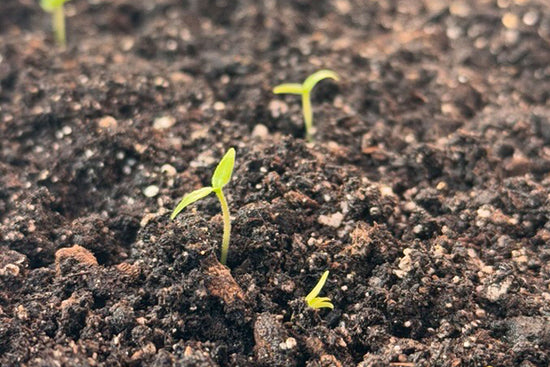
What is Germination?
Germination is the process where a seed begins to grow into a plant. It starts when the seed absorbs water, triggering internal changes that lead to growth. The first sign is the emergence of the root (radicle), followed by the shoot. Successful germination requires the right conditions:
- Warmth: Ideal soil temperature is 75–85°F (24–29°C). Heat mats can help maintain this range.
- Moisture: The growing medium should be consistently moist but not soggy. Too much water can cause rot.
- Oxygen: Seeds need good air circulation in the soil for respiration.
- Light: Once the seedlings emerge from the soil, they’ll need strong light (like a grow lights or sunlight) to develop properly and avoid becoming leggy or weak.
- Check out our detailed Germination Instructions to learn more!
-
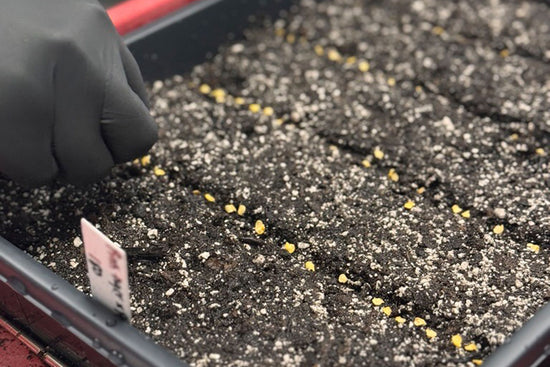
How Long do Pepper Seeds Take to Germinate?
- Sweet & Mild Peppers: 1-2 weeks under ideal conditions (75–85°F).
- Hot Peppers: 4-6 weeks -
these can be slow and sensitive to conditions.
Some seed varieties can be finicky and difficult to germinate. Although many super hot peppers take longer to germinate, trust us when we say its worth the wait!
If your seeds didn't germinate in the expected time frame after following our Germination Instructions, please contact our team and we would be happy to assist you!
-
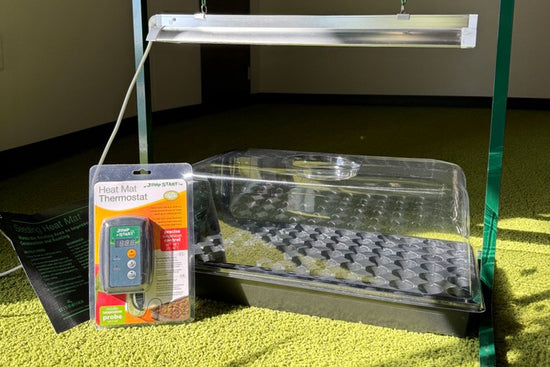
What Supplies Do I Need to Germinate Pepper Seeds?
For successful pepper seed germination, we recommend investing in the following Seed Starting Supplies:
- Seed-Starting Mix - A light, well-draining, sterile mix (not garden soil).
- Seed Trays or Small Containers - With drainage holes to prevent waterlogging.
- Humidity Dome or Plastic Cover -Helps retain warmth and moisture.
- Heat Mat – Keeps soil at an ideal 75–85°F (24–29°C).
- Spray Bottle - For gentle, even moisture.
- Grow Light - Supports photosynthesis allowing your plants to grow and develop.
- Labels
-
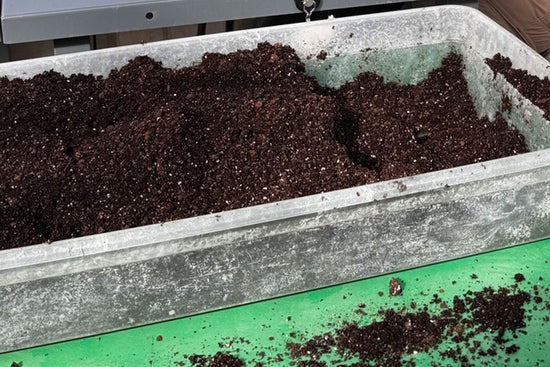
What Do I Use for Seed Starting Mix?
There are many good seed starting mixes available at nurseries. They work very well and they don't require mixing or measuring. A great option is FoxFarm's Happy Frog Potting Mix.
If you prefer to make your own mixture, we recommend you go with 1/3 good garden soil (don't go with clay soil as it compacts badly), 1/3 composted cow manure or similar growing medium, and 1/3 sand. Hot pepper plants love sand as many varieties originate in areas with sandy soil. Also, it provides excellent drainage. Mix all 3 ingredients together very well and you're ready to plant.
-
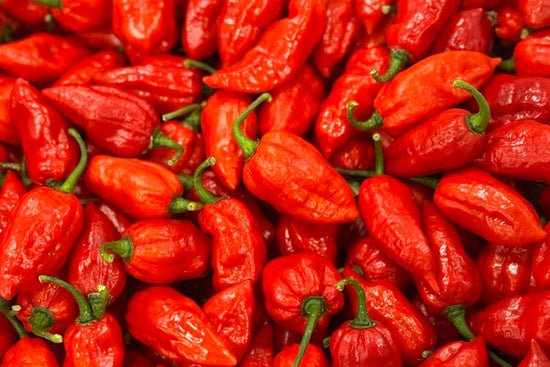
What Are Scoville Heat Units?
Scoville Heat Units, or SHUs for short, measure the heat and pungency of a pepper based on its concentration of “capsaicin.” This chemical compound lives in the oils and membranes of all peppers that help give them their unique flavors and heat. The unit itself is actually a measurement of sugar water, which is used to help determine a pepper’s heat level. The more Scoville Heat Units there are, the more amounts of measurable sugar water were needed for testing. Check out our blog on the Scoville Heat Scale to learn more!
-
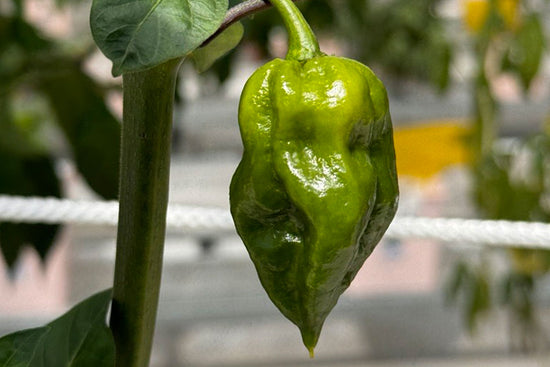
What Does "Days to Harvest" Mean?
You may notice the Days to Harvest number listed on our seeds packs. The days to harvest is an estimate on how long it may take for your pepper to ripen, whether it be from seed to harvest or transplanting pepper plants to harvest. This number varies as some peppers take more time to reach maturity.
The term days to harvest takes on different meanings depending on which form – seed versus seedling. For seeds planted in the ground, days to harvest means from seeding to maturity. Whereas, for seedlings that have grown and started indoors, the term starts from the time of transplanting to a pot or garden to maturity.
-
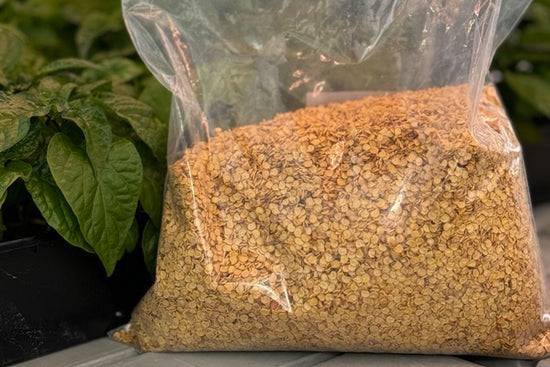
Want to Order Seeds in Bulk?
Bulk discounts are available for seed orders $300 or larger. For orders with more than 1,000 seeds, we offer bulk packaging. Please contact us if you are interested!
Live Plants FAQ
-
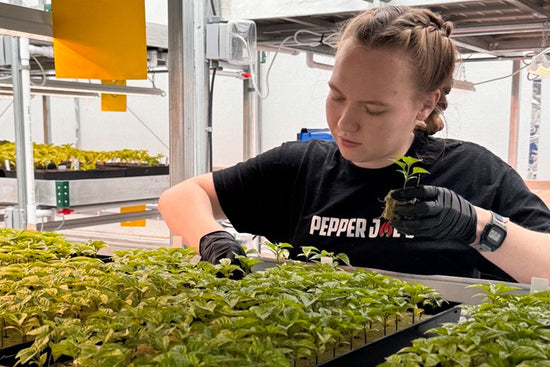
How Does Pepper Joe's Grow Live Plants?
At the Pepper Joe’s Greenhouse, our growers start thousands of pepper seeds each season to produce healthy live plants. We carefully select unique varieties, specializing in rare and super-hot peppers. Each plant is nurtured with care to develop strong stems and healthy root systems. They stand 2–6 inches tall and already have their true leaves—allowing you to get a jumpstart in your garden!
-
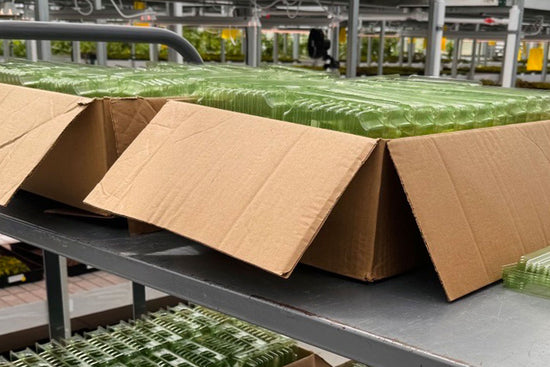
When Will My Plants be Delivered?
Orders placed from January through April are considered preorders. Reserving in advance ensures you get the varieties you want and helps you plan ahead for your garden. In our checkout, you are able to select your desired delivery date for your plant order. If you missed this section, no worries. We will select the earliest delivery week available for you! Our team begins shipping live plants in April, prioritizing orders based on delivery weeks. After all preorders have been shipped, we begin fulfilling new orders in real time. You can tell if a live plant is a preorder by looking for the 'Preorder' badge on the product image. Additionally, once orders are being shipped in real time, you will see an Estimated Delivery section on the plant product page. Simply add your zip code for an estimate.
-
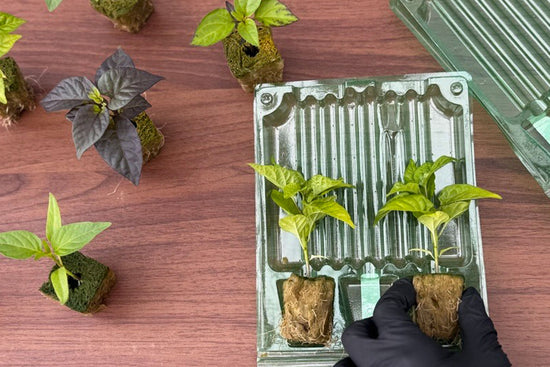
My Live Plants Arrived, What Do I Do Next?
1. Unbox Your Plant
- Gently remove the plant from its box and packaging.
- Inspect the plant for any damage.
- Leave the rock wool intact - don't remove it! The rock wool is there to protect the delicate roots.
2. Pot Your Plant
- Place the rock wool end of your plant about 2-3 inches into your favorite potting soil. Give it a good drink of water right after planting. Keep an eye on the soil moisture. Be careful not to overwater, as pepper plants don't like soggy roots.
3. Harden Off Your Plants
Plants adjust to small, gradual changes in their environment better than sudden shifts—that’s what hardening off is all about. To prevent sun damage, introduce your seedlings to outdoor conditions slowly:
- Days 1-3: Start in a shaded, sheltered spot for 1-2 hours a day.
- Days 4-7: Gradually increase direct sunlight for 2-4 hours, then bring indoors.
- Weeks 2-3: If your plants not ready, continue to gradually increase direct sun by 1-2 hours each day until your plants thrive in full sun.
For more information, check out our Live Plant Care Instructions.
-
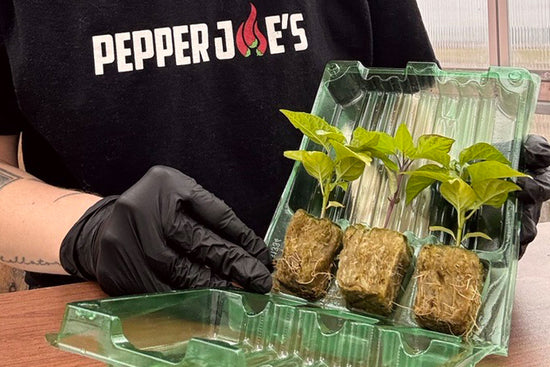
What Kind of Packaging Are Live Plants Sent in?
Our live pepper plants are safely shipped in our 100% recyclable custom plant packaging. We've used custom packaging to securely protect your plant and its roots during transit, ensuring they arrive in great condition. Check out our blog on How Pepper Joe's ships live plants!
-
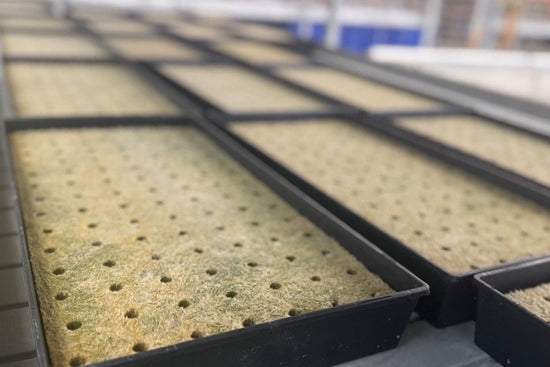
What is Rock Wool?
The rock wool surrounding the live plant's roots plays a key role. it’s a lightweight hydroponic material that helps maintain the perfect balance of moisture and oxygen, while also shielding the roots from pests and diseases. Before we ship out each live plant order, we give them a "little bath" so the rock wool has the proper amount of moisture during its journey from the Greenhouse to you!
-

When Can I Move Live Plants Outside?
A good tme to move your plants outside is after the last frost. Wait until all danger of frost has passed in your area. Peppers love warm weather so make sure your area is experiencing these temperatures consistently:
- Daytime: Above 70°F (21°C)
- Nighttime: Stay above 55°F (13°C)
Once you have completed the hardening off process and your plants are thriving in the full sun, you are ready to fully transition your plants outside. -
My Live Plant Arrived Droopy, What Do I Do?
If your live plants arrive droopy, don't panic. Water your plant immediately after arrival and give it 24 hours to recover. A bit of wilting after shipping is normal and usually resolves once your plant settles in. If it hasn't bounced back after a day, reach out to ur email and include a picture. We will make it right!
Plant Care FAQ
-
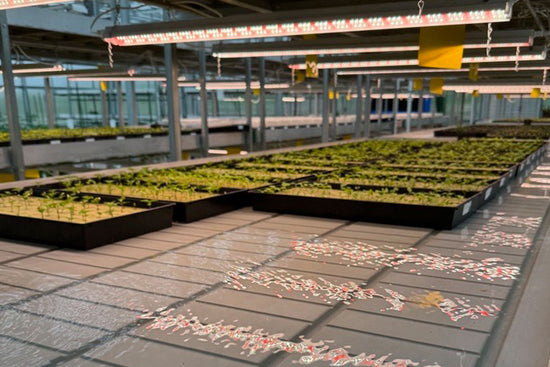
How Often Should I Water My Pepper Plants?
Watering pepper plants is a delicate balance. As your pepper plants grow and change, so do the water requirements.
Follow these guidelines to ensure your pepper plants receive the right amount of water:
- Soil Moisture Test
The most reliable way to gauge watering needs is to conduct a soil moisture test. Insert your finger about an inch into the soil near the plant's root zone. If it feels dry, it's time to water. If it feels moist, wait a day or two before watering. - Observing Plant Signs
Keep a close eye on your pepper plants for signs of water stress. Wilting leaves, drooping stems, and dull foliage can indicate the need for watering. Be cautious not to mistake overwatering signs, such as yellowing leaves and root rot, for dehydration. - Pepper Watering Schedule
In general, pepper plants benefit from deep, infrequent watering rather than frequent shallow watering. This promotes robust root development as roots grow deeper in search of moisture. Water your plants thoroughly until water begins to drain from the bottom, then allow the top inch or two of soil to dry out before the next watering. - Adjusting for Climate
Adapt your watering schedule to accommodate the climate in your area. In hot and dry conditions, you may need to water every two to three days. In cooler and more humid climates, you can extend the intervals between watering to five to seven days. - Rainfall Considerations
If your region receives regular rainfall, you may need to water less frequently. On the other hand, during extended dry periods, supplemental watering becomes crucial.
- Soil Moisture Test
-
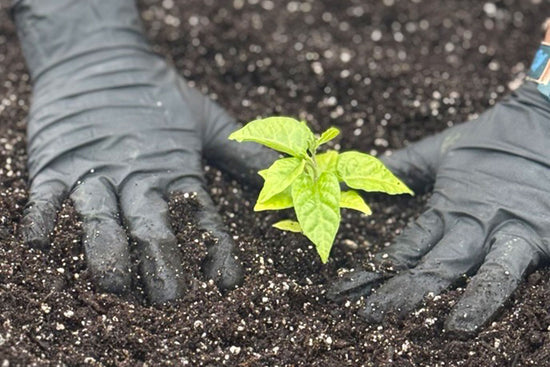
How Much Sun Do Pepper Plants Need?
Seedlings can be a bit demanding when it comes to the sunlight they require. If you start growing indoors, your plants may be accustomed to indoor grow lights. Once they are mature enough to transition outdoors, we recommend you pick a location where the plants will receive at least 6-12 hours of direct sunlight throughout the growing season.
The morning sun is favorable because it is less intense than the afternoon sun. If your plant receives at least 6-12 hours of sunlight, it will have more energy to grow tall and strong. If your plant only receives 6 hours or less of sunlight, it will likely have a smaller harvest.
-
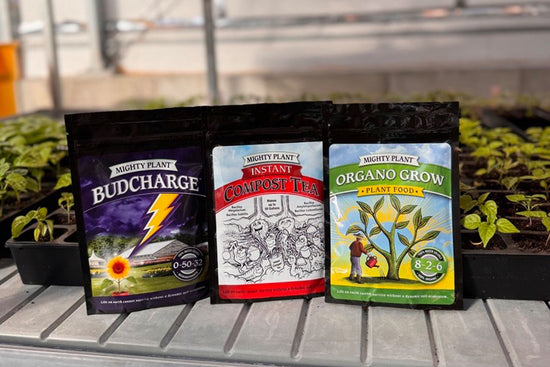
When Do I Fertilize My Pepper Plants?
Pepper seeds contain all the nutrients they need for healthy initial growth. There is no need to fertilize your seedlings until they develop 4 to 6 "true leaves" and are several inches tall. At this point, you can begin using fertilizer at quarter-strength, slowly increasing fertilizer strength as they grow. We have several fertilizers we stand by from Mighty Plant:
- Mighty Plant Instant Compost Tea - Excellent for all stages of plant growth. This is a compost tea alternative that contains essential nutrients and beneficial microbes that enhance soil fertility. The ingredients boost plant growth, improve stress resistance, and support overall plant health.
- Mighty Plant Organo Grow Soluble Plant Food - For use in the vegetative stage. Offers the benefits of a standard fertilizer but goes a step further by including vital amino acids, peptides, and biostimulants made to increase the plant's ability to more efficiently uptake nutrients.
- Mighty Plant BudCharge Plant Food - For use late in the bloom stage. Bloom stage is when your plants needs more Phosphorous and Potassium to support big buds. BudCharge triggers bud development and promotes high trichome density and large heavy buds rich in aromatic terpenes and resins.
-
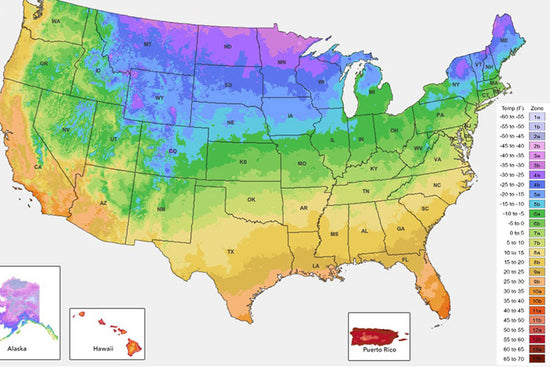
What is My Planting Zone?
The USDA Grow Zone Map is the go-to standard for gardeners and growers. This map determines which perennial plants are most likely to thrive at a specific location. It's important that your perennial plants are hardy enough to survive the winter in your area. Winter damage occurs the most when plants are planted out of their range. If you take a look at the map, you will see a scale. The 1-13 categorizes every location in the United States by its coldest average temperature of the year.
- The coldest regions are a 1 on the scale.
- The hottest regions are 13.
- The scale is further divided by temperature. For example, 1a is colder than 1b and 2a is colder than 2b.
Check out our blog on Planting Zones to understand the other factors to consider like Microclimates.
-
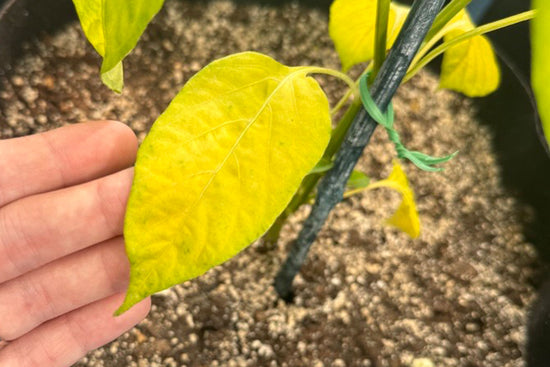
My Plant's Leaves are Turning Yellow, What Do I Do?
The first step in fixing yellow leaves is identifying the root case.
Check Watering Habits:
- Too much water = soggy roots, yellowing, wilting
- Too little water = dry soil, stressed plant
Fix: Water when the top inch of soil feels dry. Make sure pots have drainage.
Look at Nutrients:
- Pale, yellowing lower leaves often mean nitrogen deficiency
- Yellowing between leaf veins = possible magnesium or iron deficiency
Fix: Begin using a balanced fertilzer. A balanced fertilizer is one that contains equal or nearly equal amounts of the three primary plant nutrients:
- Nitrogen (for leaf and stem growth)
- Phosphorus (for root and flower development)
- Potassium (for overall plant health and disease resistance)
Consider Pot Size & Drainage
- Roots may be cramped or sitting in wet soil
Fix: Repot if root-bound or improve drainage.
-
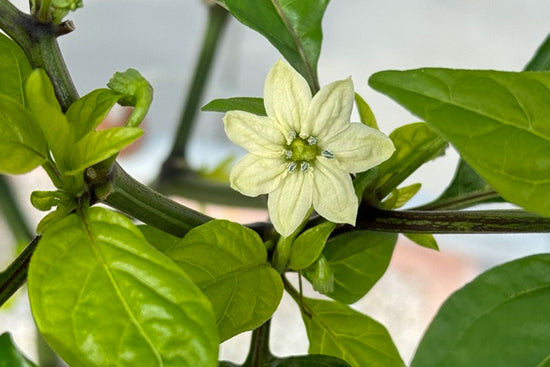
Pepper Plant Flowering 101
1. When do pepper plants start flowering?
Most pepper plants start to flower about 8-12 weeks after germination once they're well-established. Flowers are the first sign that fruit is on the way! Each one can become a pepper—if it’s pollinated and the plant is strong enough to support the growth.
2. Should I remove the first flowers?
Yes if the plant is still young or small. Pinching early blooms helps the plant focus on root and leaf growth first, which can lead to more fruit later on. Once your plant is bushier and more mature, let it flower freely.
3. Do I need to hand-pollinate pepper flowers?
If your plants are growing indoors or in a greenhouse, a little help can go a long way! Gently shake the plant, use a soft brush, or tap the flowers to mimic wind or pollinators. Outdoors, nature usually takes care of it.
4. Why are my flowers falling off before fruit forms?
Blossom drop can be caused by:
- Temperature stress (too hot or too cold)
- Overwatering or poor drainage
- Inconsistent humidity or moisture levels
- Limited container/root space
- Poor pollination
- Nutrient imbalance (especially too much nitrogen)
To help prevent it, keep your plant consistently watered, avoid extreme temperatures, and ensure it’s getting enough light, air flow, and the right nutrients.
5. What fertilizer helps with flowers & fruit?
Once your plant is established, switch to a low-nitrogen, higher-phosphorus and potassium fertilizer.
BudCharge fertilizer promotes more blossoms, better fruit set, and stronger development of pods. It helps redirect the plant's energy from leafy growth to flower and fruit production.
-
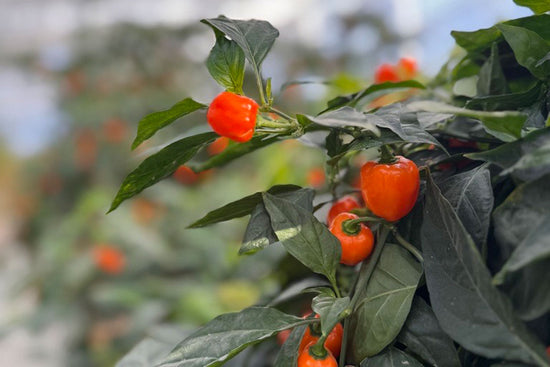
When is the Right Time to Harvest Peppers?
Knowing when your peppers are ripe is the key to harvesting at the right time. The general rule of thumb for maturity of sweet peppers is 60-90 days, and hot peppers can mature around 90 days and up to 150 days. Make sure you know the final ripe color of your pepper variety—that way, you’ll recognize when it’s ready to pick.
Peppers are unique because you can harvest them at any color after they hit the maturity stage. For example, you can pick a Czech Black pepper during the purple/black stage or when it turns ruby red, and it will still be delicious! Pick the peppers when they are the size and color you want, and make sure they are firm.
Note: The more peppers you pick, the more peppers that will continue growing on your plant. Keep removing the peppers as soon as they are ripe so you can grow more!
-
How Do I Prevent Pests?
The most common pests that can damage your peppers are aphids and spider mites. If you're currently dealing with these pests, it's essential to act quickly to prevent the pests from spreading.
We recommend following this DIY and inexpensive solution to Get Rid of Pests on Pepper Plants.:
- Whisk together 1 tablespoon of dawn dish soap, 1 tablespoon of vegetable oil, and 1 gallon of warm soft water (tap water is preferred) in a bucket.
- After it’s mixed, spray and apply it in an even coat to the entire plant and coat the underside of the leaves where pests like to hide. The mix will work best when in it's in direct contact with the pests. The solution will not penetrate eggs so you will want to apply the soapy water to the plant once every four to seven days until the infestation is gone. If you wish to maximize the results, spray it in the early morning or as the sun sets so the mixture will not evaporate quickly. Just like when you use the sprinklers to water your lawn!
This solution is great at controlling infestations of many pests such as aphids, spider mites, whiteflies, and thrips.
-
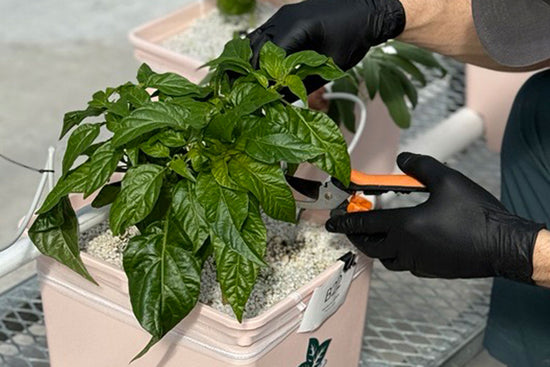
Should I Prune My Pepper Plants?
Pruning pepper plants is the practice of selectively cutting off parts of the plant—usually leaves, stems, or early flowers—to improve growth, airflow, and fruit production. Pruning is not a required step but our team has found great value in this process.
Types of Pruning:- Topping – Cutting off the top of the main stem when the plant is young (usually 4–6 inches tall). This encourages it to branch out and become bushier.
- Removing suckers – Snipping small shoots that grow in the "V" between the main stem and a branch, to direct energy to fewer, stronger branches.
- Thinning lower leaves – Improves airflow and reduces the risk of soil-borne diseases.
- Removing early flowers – In young plants, this helps redirect energy to vegetative growth before fruiting.
Benefits of Pruning:
- Encourages bushier plants and more branching
- Increase fruit yield and size
- Improves airflow, reducing disease risk
- Helps sunlight reach more of the plant
-
How Do I Overwinter My Pepper Plants?
Overwintering means bringing them indoors to survive the cold months. Since peppers can’t handle frost, this method helps your favorites rest and return stronger next season.
1. Why Overwinter?
- Save time & resources: Your overwintered plant will pick up right where it left off when warm weather returns.
- Faster fruiting for next season: Established roots wake up quickly, producing earlier growth and bigger harvests.
- Preserve favorites: Especially great for rare or super hot varieties that take a longer time to ripen.
- Bonus: With grow lights and a warm setup, you can even keep them producing indoors like we do! Just watch for pests!
2. When to Overwinter Plants
Begin the overwintering process when overnight temperatures begin to dip into the mid-40s Fahrenheit (~7°C). At this time, plants will begin dropping leaves and slowing down growth.
3. Choose Your Best Plants
Pick your healthiest, most productive plants. These are the ones worth keeping for round two. Varieties that take longer to ripen, like many super hots, benefit the most from overwintering.
4. Prune Your Plants
Trim back branches, leaving a few nodes on the main stem. As long as a few nodes remain, your plant will have what it needs to regrow next year. Don't forget to remove all leaves!
5. Repot and Relocate
Gently dig up the plant, keeping the root ball intact. Shake off excess soil and rinse roots under lukewarm water to remove pests or debris. Trim any damaged roots, then repot in fresh, well-draining soil.
Pro tip: A quick dip in mild insecticidal soap helps prevent hitchhiking pests.6. Keep it Dry and Cool
Store in a cool (55–60°F / 13–15°C) spot. This temperature will dramatically slow the growth of the plant and help initiate dormancy. Water sparingly—just enough to keep the soil slightly moist. Overwatering during dormancy is a common mistake.
7. Wake Them Up in the Spring
As the weather warms, move your plant outside gradually to re-acclimate it to sunlight. You’ll have a head start on the growing season with a mature plant that’s weeks ahead of seedlings!

